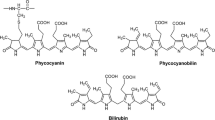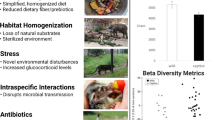Abstract
Most antioxidants have multiple functions; in addition to minimizing oxidative damage, many antioxidants have immune-modulating properties. For example, biliverdin is produced in the liver and spleen from the breakdown of heme, and has putative immune-suppressing and antioxidant properties. However, the majority of these properties have been investigated in vitro or in mammalian models, in which biliverdin reductase converts virtually all biliverdin to bilirubin. Thus, biliverdin’s physiological roles remain largely untested. Here, we investigated whether biliverdin has immunomodulating roles by injecting Northern Bobwhite quail (Colinus virginianus) with either a vehicle control, lysed and rinsed pig red blood cells (pRBC) that contain erythrocyte antigens but no heme, or intact pRBC that contain both erythrocyte antigens and hemoglobin, thus increasing the amount of heme that can be converted to biliverdin. We then quantified hemagglutination and hemolysis ability, and biliverdin concentration in the liver and spleen, on 3, 6, and 9 days post-injection. We found that hemagglutination was greater in individuals that received intact pRBC, but not in those injected with heme-removed pRBC, demonstrating that biliverdin does not suppress immune function at this dosage. Biliverdin levels of liver and spleen were correlated within individuals, suggesting organism-level variation in biliverdin production. Lastly, individuals injected with intact pRBC had a reduced biliverdin concentration in the spleen, suggesting that immune challenges may reduce biliverdin production or accumulation. This initial investigation demonstrated that biliverdin may have more nuanced physiological roles than previously reported, supporting the value of further investigations into the physiology of biliverdin.





Similar content being viewed by others
References
Austin CCC, Jessing KKW (1994) Green-blood pigmentation in lizards. Comp Biochem Physiol Part A Physiol 109:619–626. https://doi.org/10.1016/0300-9629(94)90201-1
Balaban RS, Nemoto S, Finkel T (2005) Mitochondria, oxidants, and aging. Cell 120:483–495. https://doi.org/10.1016/j.cell.2005.02.001
Basiglio CL, Arriaga SM, Pelusa F et al (2010) Complement activation and disease: protective effects of hyperbilirubinaemia. Clin Sci 118:99–113. https://doi.org/10.1042/CS20080540
Bellner L, Wolstein J, Patil K et al (2011) Biliverdin rescues the HO-2 null mouse phenotype of unresolved chronic inflammation following corneal epithelial injury. Investig Ophthalmol Vis Sci 52:3246–3253. https://doi.org/10.1167/iovs.10-6219
Berlec A, Štrukelj B (2014) A high-throughput biliverdin assay using infrared fluorescence. J Vet Diagn Investig 26:521–526. https://doi.org/10.1177/1040638714535403
Bisht K, Wegiel B, Tampe J et al (2014) Biliverdin modulates the expression of C5aR in response to endotoxin in part via mTOR signaling. Biochem Biophys Res Commun 449:94–99. https://doi.org/10.1016/j.bbrc.2014.04.150
Bonkovsky HL, Guo J-T, Hou W et al (2013) Porphyrin and Heme Metabolism and the Porphyrias. In: Comprehensive Physiology. Wiley, Hoboken, pp 365–401
Bucasas KL, Franco LM, Shaw CA et al (2011) Early patterns of gene expression correlate with the humoral immune response to influenza vaccination in humans. J Infect Dis 203:921–929. https://doi.org/10.1093/infdis/jiq156
Butler MW, Ligon RA (2015) Interactions between biliverdin, oxidative damage, and spleen morphology after simulated aggressive encounters in veiled chameleons. PLoS One 10:e0138007. https://doi.org/10.1371/journal.pone.0138007
Butler MW, McGraw KJ (2012) Developmental immune history affects adult immune function but not carotenoid-based ornamentation in mallard ducks. Funct Ecol 26:406–415. https://doi.org/10.1111/j.1365-2435.2011.01942.x
Butler MW, McGraw KJ (2013) Immune function is related to adult carotenoid and bile pigment levels, but not dietary carotenoid access during development, in female mallard ducks. J Exp Biol 216:2632–2640. https://doi.org/10.1242/jeb.082982
Butler MW, Stahlschmidt ZR, Ardia DR et al (2013) Thermal sensitivity of immune function: evidence against a generalist-specialist trade-off among endothermic and ectothermic vertebrates. Am Nat 181:761–774. https://doi.org/10.1086/670191
Butler MW, Lutz TJ, Fokidis HB, Stahlschmidt ZR (2016) Eating increases oxidative damage in a reptile. J Exp Biol 219:1969–1973. https://doi.org/10.1242/jeb.138875
Butler MW, Bociulis SC, Little AR et al (2017) Quantifying biliverdin in liver and spleen samples from multiple avian species. Auk 134:11–21. https://doi.org/10.1642/AUK-16-73.1
Casagrande S, Costantini D, Groothuis TGG (2012) Interaction between sexual steroids and immune response in affecting oxidative status of birds. Comp Biochem Physiol Part A Mol Integr Physiol 163:296–301. https://doi.org/10.1016/j.cbpa.2012.07.018
Cooper-Mullin C, McWilliams SR (2016) The role of the antioxidant system during intense endurance exercise: lessons from migrating birds. J Exp Biol 219:3684–3695. https://doi.org/10.1242/jeb.123992
Costantini D, Møller AP (2008) Carotenoids are minor antioxidants for birds. Funct Ecol 22:367–370. https://doi.org/10.1111/j.1365-2435.2007.01366.x
Costantini D, Verhulst S (2009) Does high antioxidant capacity indicate low oxidative stress? Funct Ecol 23:506–509. https://doi.org/10.1111/j.1365-2435.2009.01546.x
Costantini D, Dell’Ariccia G, Lipp H-P (2008) Long flights and age affect oxidative status of homing pigeons (Columba livia). J Exp Biol 211:377–381. https://doi.org/10.1242/jeb.012856
Costantini D, Rowe M, Butler MW, McGraw KJ (2010) From molecules to living systems: historical and contemporary issues in oxidative stress and antioxidant ecology. Funct Ecol 24:950–959. https://doi.org/10.1111/j.1365-2435.2010.01746.x
De Marchi L, Neto V, Pretti C et al (2017) The impacts of emergent pollutants on Ruditapes philippinarum: biochemical responses to carbon nanoparticles exposure. Aquat Toxicol 187:38–47. https://doi.org/10.1016/j.aquatox.2017.03.010
Dodds AW, Matsushita M (2007) The phylogeny of the complement system and the origins of the classical pathway. Immunobiology 212:233–243. https://doi.org/10.1016/j.imbio.2006.11.009
Dowling DK, Simmons LW (2009) Reactive oxygen species as universal constraints in life-history evolution. Proc R Soc B Biol Sci 276:1737–1745. https://doi.org/10.1098/rspb.2008.1791
Giraudeau M, Sweazea K, Butler MW, McGraw KJ (2013) Effects of carotenoid and vitamin E supplementation on oxidative stress and plumage coloration in house finches (Haemorhous mexicanus). Comp Biochem Physiol Part A Mol Integr Physiol 166:406–413. https://doi.org/10.1016/j.cbpa.2013.07.014
Golden JM, LaCasse CJ, Simova DV et al (2008) Differential mediator production by dendritic cells upon toll-like receptor stimulation does not impact T cell cytokine expression. Immunol Lett 118:30–35. https://doi.org/10.1016/j.imlet.2008.02.011
Gonzalez-Sanchez E, Perez MJ, Nytofte NS et al (2016) Protective role of biliverdin against bile acid-induced oxidative stress in liver cells. Free Radic Biol Med 97:466–477. https://doi.org/10.1016/j.freeradbiomed.2016.06.016
Hanley D, Heiber G, Dearborn DC (2008) Testing an assumption of the sexual-signaling hypothesis: does blue-green egg color reflect maternal antioxidant capacity? Condor 110:767–771. https://doi.org/10.1525/cond.2008.8634
Hegemann A, Matson KD, Versteegh MA et al (2013) Immune response to an endotoxin challenge involves multiple immune parameters and is consistent among the annual-cycle stages of a free-living temperate zone bird. J Exp Biol 216:2573–2580. https://doi.org/10.1242/jeb.083147
Herborn KA, Daunt F, Heidinger BJ et al (2016) Age, oxidative stress exposure and fitness in a long-lived seabird. Funct Ecol 30:913–921. https://doi.org/10.1111/1365-2435.12578
Jackovitz AM, Hanna TL, Quinn MJ (2012) Relative sensitivities of japanese quail to foreign red blood cell challenges for immunotoxicity testing. J Toxicol Environ Heal Part A 75:319–323. https://doi.org/10.1080/15287394.2012.668163
Jüttner F, Stiesch M, Ternes W (2013) Biliverdin: the blue-green pigment in the bones of the garfish (Belone belone) and eelpout (Zoarces viviparus). Eur Food Res Technol 236:943–953. https://doi.org/10.1007/s00217-013-1932-y
Kaur H, Hughes MN, Green CJ et al (2003) Interaction of bilirubin and biliverdin with reactive nitrogen species. FEBS Lett 543:113–119. https://doi.org/10.1016/S0014-5793(03)00420-4
Kosaka J, Morimatsu H, Takahashi T et al (2013) Effects of biliverdin administration on acute lung injury induced by hemorrhagic shock and resuscitation in rats. PLoS One 8:e63606. https://doi.org/10.1371/journal.pone.0063606
Koutsos EA, Klasing KC (2001) The acute phase response in Japanese quail (Coturnix coturnix japonica). Comp Biochem Physiol Part C Toxicol Pharmacol 128:255–263
Kumral A, Tuzun F, Ozbal S et al (2012) Lipopolysaccharide-preconditioning protects against endotoxin-induced white matter injury in the neonatal rat brain. Brain Res 1489:81–89. https://doi.org/10.1016/j.brainres.2012.10.015
Lessells C, Boag PT (1987) Unrepeatable repeatabilities: a common mistake. Auk 104:116–121
Lucas A, Morales J, Velando A (2014) Differential effects of specific carotenoids on oxidative damage and immune response of gull chicks. J Exp Biol 217:1253–1262. https://doi.org/10.1242/jeb.098004
Lumeij JT (1994) Hepatology. In: Ritchie B, Harrison G, Harrison L (eds) Avian Medicine: Principles and Applications. Wingers Publishing, Inc., Lake Worth, pp 522–537
Mancuso C, Barone E, Guido P et al (2012) Inhibition of lipid peroxidation and protein oxidation by endogenous and exogenous antioxidants in rat brain microsomes in vitro. Neurosci Lett 518:101–105. https://doi.org/10.1016/j.neulet.2012.04.062
Matson KD, Ricklefs RE, Klasing KC (2005) A hemolysis-hemagglutination assay for characterizing constitutive innate humoral immunity in wild and domestic birds. Dev Comp Immunol 29:275–286. https://doi.org/10.1016/j.dci.2004.07.006
McDonagh AF (2001) Turning green to gold. Nat Struct Biol 8:198–200. https://doi.org/10.1038/84915
McGraw KJ, Nolan PM, Crino OL (2011) Carotenoids bolster immunity during moult in a wild songbird with sexually selected plumage coloration. Biol J Linn Soc 102:560–572. https://doi.org/10.1111/j.1095-8312.2010.01594.x
Merkling T, Blanchard P, Chastel O et al (2017) Reproductive effort and oxidative stress: effects of offspring sex and number on the physiological state of a long-lived bird. Funct Ecol 31:1201–1209. https://doi.org/10.1111/1365-2435.12829
Metcalfe NB, Alonso-Alvarez C (2010) Oxidative stress as a life-history constraint: the role of reactive oxygen species in shaping phenotypes from conception to death. Funct Ecol 24:984–996. https://doi.org/10.1111/j.1365-2435.2010.01750.x
Millet S, Bennett J, Lee KA et al (2007) Quantifying and comparing constitutive immunity across avian species. Dev Comp Immunol 31:188–201. https://doi.org/10.1016/j.dci.2006.05.013
Mölzer C, Huber H, Steyrer A et al (2012) In vitro antioxidant capacity and antigenotoxic properties of protoporphyrin and structurally related tetrapyrroles. Free Radic Res 46:1369–1377. https://doi.org/10.3109/10715762.2012.715371
Monaghan P, Metcalfe NB, Torres R (2009) Oxidative stress as a mediator of life history trade-offs: mechanisms, measurements and interpretation. Ecol Lett 12:75–92. https://doi.org/10.1111/j.1461-0248.2008.01258.x
Nakagawa S, Cuthill IC (2007) Effect size, confidence interval and statistical significance: a practical guide for biologists. Biol Rev 82:591–605. https://doi.org/10.1111/j.1469-185X.2007.00027.x
Overhaus M, Moore BA, Barbato JE et al (2006) Biliverdin protects against polymicrobial sepsis by modulating inflammatory mediators. Am J Physiol Gastrointest Liver Physiol 290:G695-703. https://doi.org/10.1152/ajpgi.00152.2005
Piantadosi CA, Withers CM, Bartz RR et al (2011) Heme oxygenase-1 couples activation of mitochondrial biogenesis to anti-inflammatory cytokine expression. J Biol Chem 286:16374–16385. https://doi.org/10.1074/jbc.M110.207738
Sadd BM, Siva-Jothy MT (2006) Self-harm caused by an insect’s innate immunity. Proc R Soc B Biol Sci 273:2571–2574. https://doi.org/10.1098/rspb.2006.3574
Sarady-Andrews JK, Liu F, Gallo D et al (2005) Biliverdin administration protects against endotoxin-induced acute lung injury in rats. Am J Physiol Lung Cell Mol Physiol 289:L1131-7. https://doi.org/10.1152/ajplung.00458.2004
Sies H, Stahl W (1995) Vitamins E and C, beta-carotene, and other carotenoids as antioxidants. Am J Clinical Nutr 62:1315S–1321S. PMID:7495226
Sorci G, Faivre B (2009) Inflammation and oxidative stress in vertebrate host-parasite systems. Philos Trans R Soc B Biol Sci 364:71–83. https://doi.org/10.1098/rstb.2008.0151
Stier KS, Almasi B, Gasparini J et al (2009) Effects of corticosterone on innate and humoral immune functions and oxidative stress in barn owl nestlings. J Exp Biol 212:2085–2091. https://doi.org/10.1242/jeb.024406
Stocker R, Peterhans E (1989) Antioxidant properties of conjugated bilirubin and biliverdin: biologically relevant scavenging of hypochlorous acid. Free Radic Res 6:57–66
van de Crommenacker J, Horrocks NPC, Versteegh MA et al (2010) Effects of immune supplementation and immune challenge on oxidative status and physiology in a model bird: implications for ecologists. J Exp Biol 213:3527–3535. https://doi.org/10.1242/jeb.045591
Van Den Steen E, Snoeijs T, Pinxten R, Eens M (2007) Kinetics of primary antibody responses to sheep red blood cells in birds: a literature review and new data from great tits and European starlings. Anim Biol 57:79–95. https://doi.org/10.1163/157075607780002041
Wang J, Zhou H-C, Pan P et al (2010) Exogenous biliverdin improves the function of lung grafts from brain dead donors in rats. Transpl Proc 42:1602–1609. https://doi.org/10.1016/j.transproceed.2010.01.076
Wegiel B, Baty CJ, Gallo D et al (2009) Cell surface Biliverdin reductase mediates biliverdin-induced anti-inflammatory effects via phosphatidylinositol 3-kinase and Akt. J Biol Chem 284:21369–21378. https://doi.org/10.1074/jbc.M109.027433
Wegiel B, Gallo D, Csizmadia E et al (2011) Biliverdin inhibits Toll-like receptor-4 (TLR4) expression through nitric oxide-dependent nuclear translocation of biliverdin reductase. Proc Natl Acad Sci 108:18849–18854. https://doi.org/10.1073/pnas.1108571108
Yamashita K (2004) Biliverdin, a natural product of heme catabolism, induces tolerance to cardiac allografts. FASEB J 18:765–767. https://doi.org/10.1096/fj.03-0839fje
Zar JH (1999) Biostatistical Analysis, 4th edn. Prentice-Hall, Inc., Upper Saddle River
Zheng J, Nagda DA, Lajud SA et al (2014) Biliverdin’s regulation of reactive oxygen species signalling leads to potent inhibition of proliferative and angiogenic pathways in head and neck cancer. Br J Cancer 110:2116–2122. https://doi.org/10.1038/bjc.2014.98
Acknowledgements
We thank R. Kurt and N. Waters for valuable input, two reviewers for helpful suggestions, and J. Cannon, M. Chejlava, B. Karanfilian, E. Lubas, N. Ritter, S. Bociulis, and H. Waite for methodological assistance.
Funding
Funding was provided to MWB and JKH by Lafayette College.
Author information
Authors and Affiliations
Corresponding author
Additional information
Communicated by I. D. Hume.
Rights and permissions
About this article
Cite this article
Homsher, M.P., Astor, M.T., Hines, J.K. et al. Immune challenges decrease biliverdin concentration in the spleen of northern Bobwhite quail, Colinus virginianus. J Comp Physiol B 188, 505–515 (2018). https://doi.org/10.1007/s00360-018-1146-5
Received:
Revised:
Accepted:
Published:
Issue Date:
DOI: https://doi.org/10.1007/s00360-018-1146-5




